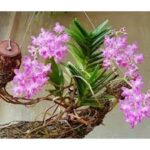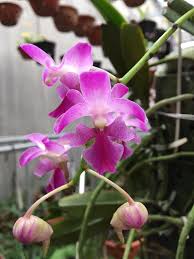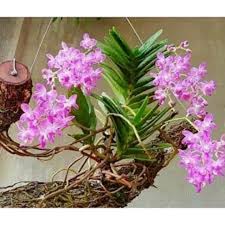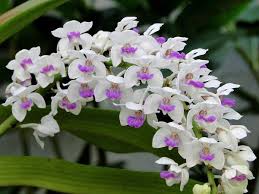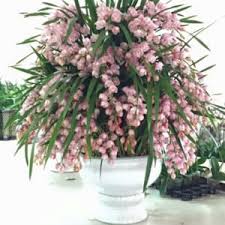
Sato Cymbidium orchids, renowned for their stunning blooms and unique characteristics, are a favorite among orchid enthusiasts and gardeners alike. One crucial aspect of caring for these beautiful plants is knowing when to repot them. Repotting is essential for maintaining the health of your orchids, promoting growth, and ensuring that they thrive in their environment. In this article, we will explore the ideal time to repot Sato Cymbidium orchids, focusing on the signs that indicate it’s time for a new pot, the best seasons for repotting, and the techniques to ensure a successful transition.
#### Understanding the Importance of Repotting
Repotting is not merely a routine task; it plays a vital role in the overall health and longevity of Sato Cymbidium orchids. Here are several reasons why repotting is essential:
1. **Nutrient Renewal**: Over time, the potting medium can decompose, losing its ability to provide essential nutrients to the plant. Repotting introduces fresh medium, enriching the plant’s nutrient supply.
2. **Root Health**: As orchids grow, their roots can become cramped within the pot. Repotting allows for more space for root expansion, preventing root rot and promoting healthy growth.
3. **Pest and Disease Control**: Old potting media can harbor pests and diseases that may affect your orchid. By repotting, you reduce the risk of infestation and promote a healthier environment.
4. **Aesthetics**: A fresh pot can improve the visual appeal of your Sato Cymbidium orchids, allowing their beauty to shine through.
#### Signs That Your Sato Cymbidium Orchid Needs Repotting
Before deciding when to repot your Sato Cymbidium orchids, it’s essential to recognize the signs that indicate they are ready for a new pot. Here are the most common indicators:
1. **Root Growth**: One of the primary signs that it’s time to repot is when you notice roots growing out of the drainage holes at the bottom of the pot. This is a clear indication that the plant has outgrown its container and needs more space.
2. **Medium Decomposition**: If you observe that the potting medium has broken down into a dense mass or is no longer airy and well-draining, it’s time to repot. Decomposed media can retain excess moisture, leading to root rot.
3. **Stunted Growth**: If your orchid has stopped growing or its growth appears sluggish, it may be a sign that the plant is root-bound and needs a larger pot to thrive.
4. **Poor Flowering**: A decline in blooming or fewer flowers than in previous years can also signal the need for repotting. Healthy roots are vital for producing beautiful blooms.
5. **Salt Buildup**: White crusty deposits on the pot surface or around the roots indicate salt buildup from fertilizers. Repotting can help remove these salts and rejuvenate the plant’s health.
#### The Best Seasons for Repotting Sato Cymbidium Orchids
Timing is critical when it comes to repotting orchids. While Sato Cymbidium orchids can be repotted at various times of the year, specific seasons are more favorable for the process.
1. **Spring**: Spring is generally considered the best time to repot Sato Cymbidium orchids. During this season, the plant is emerging from dormancy and entering a growth phase. Repotting in spring allows the orchid to acclimate to its new pot and potting medium while the roots are actively growing. This timing also helps minimize stress on the plant, increasing the likelihood of a successful transition.
2. **After Flowering**: Another ideal time for repotting is immediately after the orchid has finished blooming. At this point, the plant is usually entering a period of rest before the next growth cycle. Repotting after flowering allows you to refresh the medium and provide the necessary nutrients for the upcoming growth phase.
3. **Avoiding Repotting During Active Growth**: It’s best to avoid repotting during periods of active growth or when the plant is in bloom. Repotting during these times can cause stress and disrupt the plant’s energy, potentially leading to a decline in health and flowering.
4. **Environmental Considerations**: Additionally, consider the climate and environmental conditions when planning to repot. Avoid extreme temperatures and humidity levels that could stress the plant during the repotting process. Ideal conditions include moderate temperatures and humidity levels.
#### Techniques for Successful Repotting
Once you’ve determined that your Sato Cymbidium orchid needs repotting and identified the best time to do so, it’s crucial to follow proper techniques to ensure a successful transition. Here are some steps to follow:
1. **Gather Supplies**: Before starting the repotting process, gather all necessary supplies, including a new pot (one size larger than the current pot), fresh orchid potting medium (typically a mix of bark, perlite, and sphagnum moss), a sterilized cutting tool, and a potting tray to catch any mess.
2. **Remove the Orchid from Its Pot**: Gently remove the orchid from its current pot. Tap the sides of the pot to loosen the roots, and carefully slide the plant out, taking care not to damage the roots. If the roots are tightly bound, you may need to use a sterilized cutting tool to carefully cut away any dead or damaged roots.
3. **Inspect the Roots**: Once the orchid is out of the pot, inspect the roots for any signs of rot or damage. Healthy roots should be firm and white or green. Trim away any brown, mushy, or dead roots with your sterilized cutting tool.
4. **Prepare the New Pot**: Place a layer of fresh potting medium at the bottom of the new pot. Ensure that the pot has adequate drainage holes to prevent waterlogging.
5. **Position the Orchid**: Center the orchid in the new pot, ensuring that the root system is spread out evenly. The base of the plant should sit slightly above the potting medium to prevent crown rot.
6. **Fill with Potting Medium**: Gradually fill the pot with the fresh potting medium, gently pressing it down around the roots to eliminate air pockets. Avoid packing the medium too tightly, as orchids require good airflow around their roots.
7. **Watering After Repotting**: After repotting, water the orchid thoroughly to help settle the potting medium. Allow the excess water to drain out completely, and then place the orchid in a location with indirect sunlight to help it acclimate to its new pot.
8. **Post-Repotting Care**: After repotting, monitor the orchid closely for the first few weeks. Avoid fertilizing for about a month to allow the plant to recover from the transition. Maintain consistent humidity and water levels, adjusting as necessary to ensure the plant settles well into its new environment.
#### Conclusion
Repotting Sato Cymbidium orchids is a vital part of orchid care, allowing these stunning plants to thrive and flourish. By understanding the signs that indicate the need for repotting and recognizing the best seasons for the process, you can ensure your orchids receive the care they need to produce beautiful blooms. With the right techniques and attention to detail, repotting can be a rewarding experience that enhances the health and longevity of your Sato Cymbidium orchids. As you embark on this journey, remember that a little care goes a long way in maintaining the beauty and vitality of these extraordinary plants.
### The Ideal Time to Repot Sato Cymbidium Orchids: Part 2
In the previous section, we explored the importance of repotting Sato Cymbidium orchids, the signs indicating the need for repotting, and the best seasons to perform this crucial task. In this second part, we will delve deeper into the factors that influence the timing of repotting, common misconceptions, expert recommendations, and the aftercare necessary for your orchids post-repotting. Understanding these aspects will ensure that your Sato Cymbidium orchids thrive in their new environment and continue to produce the stunning blooms they are known for.
#### Factors Influencing the Timing of Repotting
Several factors can influence when it’s best to repot your Sato Cymbidium orchids. Understanding these factors will help you make an informed decision on the ideal timing for repotting.
1. **Growth Cycle**: Sato Cymbidium orchids have a distinct growth cycle that typically consists of a growth phase, a flowering phase, and a resting phase. Understanding this cycle is crucial. Repotting should ideally occur during the resting phase or at the beginning of the growth phase, when the plant is most resilient and ready to adapt to changes.
2. **Environmental Conditions**: The climate and environmental conditions in your area can also impact the timing of repotting. For example, if you live in a region with distinct seasons, spring is usually the best time to repot as temperatures begin to rise, and daylight increases. Conversely, in tropical regions with consistent climates, you may need to monitor the individual health and growth of your orchids to determine the best time.
3. **Potting Medium Type**: The type of potting medium used can influence how often you need to repot. Organic media like bark and sphagnum moss break down over time, leading to a need for more frequent repotting compared to inorganic media like perlite or coconut coir, which tend to last longer without degradation.
4. **Plant Size and Age**: The size and age of your Sato Cymbidium orchid can also dictate how often you should repot. Younger orchids or those still actively growing may need to be repotted more frequently as they outgrow their pots quickly, while older, more established plants can often go longer between repotting sessions.
5. **Container Size**: If you notice that your Sato Cymbidium orchid has significantly outgrown its container, it may be necessary to repot sooner rather than later, even if it’s not spring. A larger pot will provide more room for root expansion, which is essential for healthy growth.
#### Common Misconceptions About Repotting
There are several misconceptions surrounding the repotting of orchids, particularly regarding the timing and process. Understanding these misconceptions can help you avoid mistakes that could harm your plants.
1. **Repotting Only When Necessary**: Many orchid growers believe they should only repot when their orchids are visibly suffering or outgrowing their pots. While it is essential to address these issues, proactive repotting during the right seasons can prevent these problems before they occur. Regularly refreshing the potting medium and inspecting the roots can promote healthier growth.
2. **Repotting During Bloom**: Some growers mistakenly believe that they should wait until their orchids finish blooming before repotting. While it’s generally advisable to avoid repotting during active blooming, some species can handle repotting while in bloom if necessary. However, it’s best to minimize disturbances during this delicate phase.
3. **All Orchids Have the Same Repotting Needs**: Not all orchids have the same repotting requirements. Each species has its specific needs based on growth habits, root systems, and environmental preferences. Understanding the unique characteristics of Sato Cymbidium orchids will help you tailor your repotting approach to suit their specific needs.
4. **Immediate Fertilization After Repotting**: Some growers believe that they should fertilize their orchids immediately after repotting to encourage growth. While it’s tempting to provide nutrients right away, it’s essential to wait for about four weeks after repotting. This waiting period allows the plant to recover from the stress of repotting and acclimate to its new potting medium.
#### Expert Recommendations for Repotting
To ensure the best results when repotting your Sato Cymbidium orchids, consider these expert recommendations:
1. **Timing with Seasonal Changes**: Pay attention to the changes in seasons, particularly in temperature and humidity. As spring approaches and the days get longer, your orchid will be more receptive to repotting. Utilize a calendar to track seasonal changes, so you can plan repotting sessions accordingly.
2. **Conduct Regular Inspections**: Make it a habit to inspect your orchids regularly. Look for signs of root growth, medium degradation, or pest infestations. Performing routine checks will allow you to catch any potential issues early and schedule repotting when necessary.
3. **Choose the Right Pot Size**: When repotting, choose a pot that is only slightly larger than the previous one. A common mistake is opting for a pot that is too large, which can lead to overwatering and root rot. A pot that is one or two inches wider than the current pot is usually sufficient for healthy growth.
4. **Repotting Frequency**: As a general rule, Sato Cymbidium orchids should be repotted every one to two years, depending on their growth rate and potting medium condition. Younger plants may require annual repotting, while mature plants can often go longer without needing a change.
5. **Use Quality Potting Medium**: Invest in high-quality potting medium specifically designed for orchids. A good mix typically includes bark, perlite, and charcoal, providing excellent drainage and airflow to the roots. Avoid using regular potting soil, as it retains too much moisture and can lead to root rot.
#### Aftercare Post-Repotting
After successfully repotting your Sato Cymbidium orchids, proper aftercare is essential for helping them adjust to their new environment. Here are some key aftercare tips to follow:
1. **Placement**: After repotting, place your orchids in a location with bright, indirect sunlight. Avoid direct sunlight for the first few weeks to minimize stress on the plant. Gradually reintroduce them to their normal lighting conditions as they acclimate.
2. **Watering Schedule**: Adjust your watering schedule based on the new potting medium. Newly repotted orchids may require less frequent watering until the roots establish themselves in the fresh medium. Monitor the moisture levels and water only when the top inch of the medium feels dry.
3. **Humidity Levels**: Maintain optimal humidity levels around your orchids. Sato Cymbidium orchids thrive in humid environments, so consider using a humidity tray or misting the leaves occasionally to increase humidity levels without saturating the medium.
4. **Temperature Management**: Ensure that the temperature remains consistent after repotting. Avoid placing the orchids near drafts, heating vents, or air conditioning units that can cause sudden temperature fluctuations.
5. **Fertilization**: As mentioned earlier, avoid fertilizing for about four weeks after repotting. Once the plant has had time to acclimate, resume a balanced fertilizer regimen, using a diluted orchid fertilizer every two to four weeks during the growing season.
6. **Monitoring Health**: Keep an eye on your orchids after repotting. Look for signs of stress, such as yellowing leaves or drooping flowers. Address any issues promptly by adjusting watering, light levels, or humidity.
#### Conclusion
Knowing the ideal time to repot Sato Cymbidium orchids is crucial for their long-term health and vitality. By understanding the factors influencing the timing of repotting, debunking common misconceptions, following expert recommendations, and providing the necessary aftercare, you can ensure that your orchids continue to thrive in their new environment. With careful attention and proper care, your Sato Cymbidium orchids will reward you with stunning blooms and vibrant foliage, making them a beautiful addition to your indoor garden. Remember that repotting is not just a task; it’s an opportunity to enhance the life and beauty of these remarkable plants.

